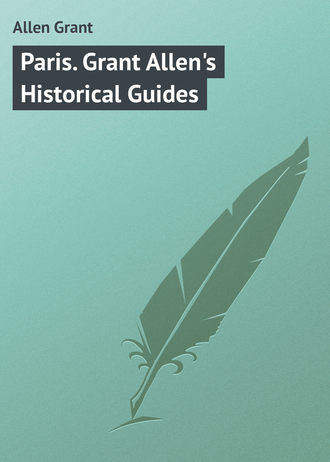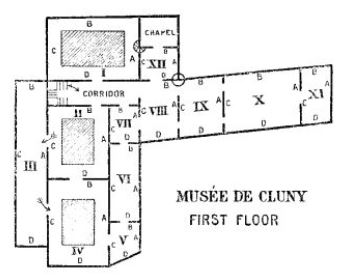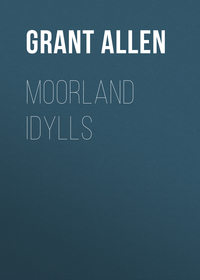 полная версия
полная версияParis. Grant Allen's Historical Guides
The centre of this room is occupied by several good statues. Examine each; the descriptive labels are usually sufficient. (A noble *St. Catherine; St. Barbara with her tower; St. Sebastian, pierced with the holes where the arrows have been; a beautiful long-haired wooden Madonna; a fine [Pisan] Angel of the Annunciation, in wood, etc.) Also, several excellent figures of Our Lady. The large part played by the Madonna in this Room, indeed, is typical of her importance in France, and especially in Paris, from the 13th century onward. The church of Notre-Dame is partly a result, partly a cause, of this special cult of the Blessed Virgin.
Room VII (beyond the corridor, a modern covered courtyard). —Tapestries and textile fabrics, interesting chiefly to ladies. On Wall A, and others, Flemish tapestry, representing the History of Bathsheba, much admired and very ugly; compare it with the tapestry of the Lady and the Unicorn, to be visited later in Room III, upstairs, contrasting them as models of what such work should and should not be. Wall B, admirable Renaissance relief of the Cardinal Virtues. Above it, a good Madonna, and figures of Grammar and Astronomy. Wall C, Caryatid of inferior art, French, 16th century. **(448), Admirable group of the Three Fates, attributed to Germain Pilon, the great French sculptor of the 16th century, whom we shall meet again at the Louvre – a fine specimen of the plastic art of the Renaissance, said to represent Diane de Poitiers and her daughters. Below **(447), exquisite Renaissance bas-relief of the huntress Diana, of the School of Jean Goujon, again in allusion to Diane de Poitiers. (478) Good mask of the same epoch. (251) Virgin and Child, meretricious; in the decadent style of the 16th century; very French in type, foreshadowing the Louis XV spirit – the Madonna resembles a little-reputable court lady. Wall D (463, etc.), Judgment of Solomon, Solomon and the Queen of Sheba, Annunciation, and other reliefs in the florid and least pleasing French style of the 16th and 17th centuries. Table by the doorway **(449), exquisite small marble statue of the Deserted Ariadne (perhaps Diane de Poitiers), in the best Renaissance manner, probably by Germain Pilon: found in the Loire, near Diane’s château of Chaumont. Beside it, three sleeping Venuses, one of which is also said to be Diane de Poitiers, the goddess of the Renaissance in Paris. L of doorway (457), singular marble relief of Christ and the Magdalen after the Resurrection (Noli me tangere); the Saviour strangely represented (as often) in a gardener’s hat and with a spade; in the background, angels by the empty sepulchre; Flemish, florid style of the 16th century. Beside it (467 and 468), two exquisite Renaissance reliefs of Venus. In front of it, on the table *(479), Entombment, with the body of Christ placed in the sarcophagus by Joseph of Arimathea and Nicodemus – portraits, I think, of the donors.
Room VIII – Textile fabrics and ecclesiastical robes. Wall B, L of door (487), pretty but meretricious little group of Venus and Cupids, with grapes, French style of the 17th century; the national taste still more distinctly showing itself. R of door (459), in two separate figures, a quaint Annunciation – French, 16th century, frankly anachronistic. Close by (464), the Judgment of Solomon, same school and period. Above (563), clever small alabaster group of the Rape of the Sabines, after Giovanni da Bologna. These all stand on a handsome French carved chest of the 16th century. Wall C, greatly worn altar-relief of the Adoration of the Magi, from the chapel of the Château d’Anet, French Renaissance, 16th century. Above it (446), Mary Magdalen, kneeling, with long hair and the alabaster box of ointment – her symbol in art – 15th century, curious. At the back, gilt and painted figures of the Holy Trinity, from the demolished church of St. Marcel at Paris, 17th century. Similar representations of the Trinity, showing the three Persons thus, are common in Italian art. Further on (493), good figure of a shepherd, French, 16th century. Wall A (266), curious altar back, Herod ordering the Massacre of the Innocents. (267) St. Eustace crossing the river (see Room VI) with the lion and the wolf seizing his children. A very different treatment from the previous one. (291) A lintel of a chimney, Flemish, dated 1555; centre, a river-god; L and R, pelican and eagle; between the figures, Faith, Hope, Charity and Prudence. (273) Madonna and Child (Notre-Dame de l’Espérance, throned on an anchor). On the wall, far L, interesting piece of French 14th century tapestry, with a legend of St. Marcel and St. John Evangelist, most naïvely represented.
Room IX. – State coaches and Sedan chairs of the 17th century, as ugly as can be imagined. They need not detain you.

MUSÉE DE CLUNY FIRST FLOOR
The staircase to the FIRST FLOOR is in the Corridor to Room VI. Observe the staircase itself, in carved wood, bearing the arms of France and Navarre, and also the crowned initials of Henri IV and Marie de Médicis. It was formerly in the old Chambre des Comptes of Paris, and was re-erected here at the installation of the Museum.
The corridor above contains arms and armour. At the head of the staircase (742), very quaint Magdalen in wood with the box of ointment; German in style, 15th century; observe her long hair, here twisted and plaited with German neatness. (1466 and 1468) Renaissance cabinets in ebony.
Room I. – Gallery, looking down on the courtyard of Room VI, below. Wall D, by which you enter; tiles, French Renaissance. Wall C: first case, blue Flemish stoneware. Fine wrought-iron gates, gilt. In front of them, female Satyr, French, 18th century, very characteristic of the national taste; opposite it, male Satyr, the same. Second case: Palissy ware, French 16th and 17th centuries. This fine ware is full of Renaissance feeling. Notice particularly (3140), a Sacrifice of Abraham; (3145) the Baptism in Jordan, conventional treatment; (3139) Judith and Holofernes, with several other scriptural scenes in the older spirit; intermingled with these are classical and mythological scenes, displaying the growing love for the nude; observe particularly (3119), a Venus with Cupids; and another dish below it, unnumbered, same subject; also, a Creation of Eve; (3131) Susanna and the Elders, and other scenes of similar character. Observe that while the early work is purely scriptural or sacred, the Renaissance introduces classical subjects. Note too the frequent scenes of the Baptism in the same connection. Centre (3102), beautiful vase with lid, of the period of Henri II. Study all the Palissy ware. Wall B, French pottery of the 18th century, exhibiting the rapid decline in taste under Louis XIV and XV, especially as regards colour. The most satisfactory pieces are the blue and white dishes with royal monograms, arms, etc. Second case: Rouen ware of the 18th century, far superior in style and tone to the preceding. Good nude figure of Venus. Wall A, Nevers pottery, delicate blue and white; (3338) figure of a page, to support a lamp. Last case: Dutch pottery, Delft, 18th century, exhibiting the strong domestic Dutch tendency.
Room II. – Also galleries, surrounding a courtyard. Exquisite Italian Renaissance pottery. Wall B, R of entrance, beautiful Italian specimens of Faenza ware, 15th and 16th centuries (whence the word faïence); these should be closely studied in detail. (2811) Quaint dish with Diana as archer; beside it, portraits. (2824 and 2825) Decorative plaques with heads of women. (3949) St. George and the Dragon in green pottery. Behind it, plate with admirable portrait. In the same case, Judith receiving the head of Holofernes; (3024) Hercules playing the lyre to entice Auge. Wall C, first case, Deruta and Chaffagiolo ware of the 16th century. Exquisite decorative dishes and plaques; (2814) Actæon changed to a stag by Diana. (2849) Susanna and the Elders. (2887) St. Jerome in the desert, with his lion. (2895) The doubting Thomas. (2823) Another Actæon. Observe frequent repetition of certain scenes. Fine plates with arms of Medici Popes, etc. Second case: Deruta ware, still more splendid specimens, many of them with remarkable lustre. (2894) Madonna and Child, with infant St. John of Florence. Other plates with Mercury, a sphinx, a lion, the huntress Diana, a Moor’s head, portraits and decorative designs. Examine in detail. Wall D, first case, Casteldurante and Gubbio ware, 16th century (3007) Manius Curtius leaping into the Forum. (3015) Crucifixion, with the sun and the moon darkened. (3004) Dædalus and the Minotaur. (3008) Fine conventional design. Other plates have heads of St. Paul and mythological persons. (2802) a quaint Temptation of St. Antony. (2818) Leda and the Swan, etc. Second case: Urbino ware, 17th century. Head of Raphael, and delicate Raphaelesque scenes, instinct with the later Renaissance feeling. (2961) Perseus and Andromeda. (3064) Expulsion from Paradise; on either side, Temptation, and Adam eating the fruit. (2872) a Baptism in Jordan. Notice again the mixture of religious and mythological scenes, with a preference for those where the nude is permissible – Judith and Holofernes, Orpheus, etc. Wall A, fine Florentine terra-cotta bust of the young St. John, patron saint of the city. More Urbino ware, to be carefully examined. The greater part of this wall, however, is occupied by **Della Robbia ware, glazed Florentine majolica of the 15th and 16th centuries. (2794) Fine figure of St. Michael. (2799) Martyrdom of St. Catherine, the wheels of her torture broken by angels. Above it, Madonna adoring the Child; observe in this and many other cases the beautiful setting of fruit and flowers, characteristic of the Delia Robbias. Beneath, no number, the Beheading of St. Catherine; in the background, angels conveying her soul to Heaven. (2795) The Infant St. John, patron Saint of Florence. (2793) Temperance, with flagon and patera. Then, more Urbino ware, very fine examples of the end of the 16th century; above them, touching Madonna and Child, Della Robbia. Wall B, again, Castello ware, and Venetian pottery, 15th, 16th and 17th centuries. Apothecary’s jars, plaques, etc., extremely beautiful.
Room III. – A long corridor. Wall A, is entirely occupied by the **magnificent suite of six early French tapestries, known as “The Lady and the Unicorn” (symbol of chastity), the finest work of its sort ever executed. They come from the Château de Boussac, and belong to the second half of the 15th century. The Lady is represented engaged in various domestic pursuits of a woman of rank of her time, always accompanied by the beast of chastity. The colour is inexpressibly lovely. Above it, similar tapestry representing the History of St. Stephen, and the Discovery of his Relics. Along Wall A, R of entrance door (774), crowned wooden figure of St. Catherine, holding the sword of her martyrdom, her broken wheel at her feet, and trampling upon the tyrant, Maximian. L of door, good early Madonna and Child; another St. Catherine; and (760) Magdalen, described (erroneously, I think) as Pandora. Wall B is mostly occupied by a handsome French Renaissance chimney-piece (16th century), brought here from a house at Rouen, and representing the history of the Casa Santa at Loreto, – its transport over the sea by angels, its reception by the Faithful, and worship in front of it. The ceiling above also comes from the same room. Wall C, small stained-glass windows of various ages. Examine them separately. Wall D, large enamelled plaques brought from François Premier’s Château of Madrid, in the Bois de Boulogne, stated to be the largest enamels in existence. Beneath them, fine wooden statue of the Virgin and infant Christ, German 15th century, very characteristic in its flat features, as well as in the dress, and treatment of the hair, of the German style of the period. Compare it with French Madonnas below. The screens towards Wall A contain specimens of fine Renaissance wood-carving. Contrast the finish and style of these with their Gothic predecessors. Notice, near the chimney-piece (828), an Annunciation, with God the Father, wearing a triple crown (like the Pope), and the Holy Spirit descending upon the Madonna. Next screen, various classical scenes in the taste of the Renaissance – Judgment of Paris, Venuses and Cupids, etc. Much fine nude Renaissance detail. Centre case, old glass; notice, in particular (4763), fine 13th century Arab mosque-lamp. Further on, more Renaissance wood-carving – Leda and the Swan in very high relief: low reliefs of classical subjects and decorative panels. All these works should be closely studied as typically illustrative of Renaissance feeling. Cases by the window (wall C), Limoges and other enamels, too numerous to treat in full detail, but many of them, at least, should be closely inspected and comprehended by the visitor. Case next the chimney-piece, old raised enamels (12th and 13th centuries), enamelled gold reliquaries for containing bones of Saints; fine crucifix, etc. Notice on 4497, the Flight into Egypt, Peter walking on the Sea, the Adoration of the Magi, and the Presentation in the Temple; on 4498, the Crucifixion, and the Twelve Apostles; beneath, 4514, enamelled book-cover; near it, Crucifixion, Adoration of the Magi, and other figures. Identify as many of these as possible, and observe their archaic striving after effects too high for the artist. Second case: Limoges enamels, more modern in type (15th century): Madonna holding the dead Christ, Crucifixion, Bearing of the Cross, and other scenes. Notice particularly (4575), little triptych with a Nativity, Adoration of the Magi, and Circumcision, in all of which observe the conventional treatment. Third case: Limoges enamels of the High Renaissance (16th and 17th centuries), Raphaelesque in spirit, better in execution, but far less interesting; good portraits in frames; a fine Flagellation, and other scenes from the Passion; above, delicate Tazzas. Observe in particular (4628), the Descent into Hell, Christ rescuing Adam and Eve and the other dead from Hades, typically Renaissance. On the far side of the case, remote from window, a good series of the Gospel history, – Marriage of the Virgin, Annunciation, Birth of the Virgin (incorrectly labelled Nativity), etc. Last cases: more recent enamels. Among the best are, in the last case of all, the Expulsion from Paradise, and a series of the Gospel History; observe particularly (4650), Christ and the Magdalen, with the usual curious disguise as a gardener. I recommend to those who can spare the time, most attentive detailed study of the subjects and treatment in all these enamels, many of which throw much light on similar themes treated by other arts in the same collection. Several hours should, if possible, be devoted to them.
Room IV contains various **Mohammedan potteries, exquisitely decorative, but (owing to the general absence of figure subjects, prohibited by Islam) requiring comparatively little explanation. Occasional animal forms, however, occur in the midst of the usually decorative arabesque patterns. Wall C, L of entrance, charming Rhodian pottery (made by Persian workmen), in prevailing tones of blue and green, with the wonderful Persian feeling for colour. Wall B, Hispano-Moorish lustre ware, the most exquisitely beautiful ever manufactured. The second case contains several lovely specimens. Wall A, Rhodian ware again. Wall D, Persian. The reader must examine these minutely for himself. It is impossible to do more than point out their beauty.
Room V. —Jewish works of art of the Middle Ages, interesting as showing the wealth and artistic taste of the mediæeval Hebrews – phylacteries, seven-branched candlesticks, goldsmiths’ work, etc. (188) Chimney-piece (Christian) from an old house at Le Mans. The groups represent the three ages of life: right and left, the two sexes – man, armed; woman, with a ball of wool.
Room VI. —Wall C, opposite windows, carved chest (1360), French, 17th century, with figures in high relief of the Twelve Apostles. The paintings above it (1704, 1707, 1714), etc., are the fronts of similar chests, Florentine, 15th century. Such boxes were commonly given to a bride to contain her trousseau and household linen. For instance, one (1710) contains the mythical history of a betrothal and wedding (Æneas and Lavinia). The others have in many cases similar appropriate subjects from classical story. (1455) Florentine mosaic cabinet, in the worst taste. Beyond it, other cabinets and fronts of wedding chests. This room also contains musical instruments, interesting as illustrating the evolution of modern forms. Also, florid Italian inlaid tables, in the bad expensive taste of the 17th century. In the windows, stained glass.
Room VII. – Carved oak cabinets. (1435) Good Flemish work of the 17th century.
Room VIII. – (189) Carved chimney-piece, similar to that in the Jewish room, and from the same house; marriage scene, allegorical. Carved wooden cabinets and portals, all interesting, but requiring little description. (1431) Again the favourite Renaissance device of Actæon and Diana. Carved oak bed, of age of François Ier, with hangings of the same period. (1509) Good panel of a chair, with the Presentation of the Virgin in the Temple by Saints Joachim and Anna; above, Nativity; then Adoration of the Magi, and Flight into Egypt; on the front, patron saints of the owners.
Room IX.—**Magnificent collection of ivories and ebonies, all of which the spectator should examine in detail. Nothing in this museum is more interesting. Notice, for example, the beautiful triptych**(1081) in the centre of the first case by the window of Wall D; lower tier, Annunciation; Shepherds; Joseph and the Madonna, with the babe in the manger; and Adoration of the Magi; upper tier, Kiss of Judas, Crucifixion, and Christ and the Magdalen in the Garden; beautiful Italian work of the 14th century. L of it **(1088), exquisite coloured triptych with Madonna and Child; L, St. Paul (with his sword) and St. Catherine; R, St. Peter and the Magdalen; notice their symbols. Several small ivories in the same case should be observed carefully. Below the large triptych, for example, are scenes from the Passion (not chronologically arranged in their existing order), namely, from L to R, Crown of Thorns, Scourging, Resurrection, Ascension, Disciples at Emmaus, Apparition to the three Marys, Peter on the Sea, and Christ with the Magdalen; very naïve French work of the 15th century. (718) Exquisite little wood-carving of the Crucifixion, with scenes from the Passion; Spanish, 16th century. Above it (7227), comb, with Adoration of the Magi; 14th century, very curious. The next case contains still earlier and more interesting work. In the centre, a triptych; lower tier, Adoration of the Magi, Madonna with angels, Presentation in the Temple; upper tier, Bearing the Cross, Crucifixion, and Descent from the Cross; exquisite French work, in high relief, of the 14th century. L of it (1082), Scenes from the Passion, Last Supper, Agony in the Garden, Kiss of Judas (with Peter cutting off Malchus’s ear), Flagellation, etc. Each compartment here consists of two subjects, which identify; charming French work of the 14th century. Above it (1085 and 1086), secular scenes, life in a garden – 14th century. R of the triptych (1065, 1063, 1066, 1064), legends of saints; St. Denis beheaded and bearing his head; Flagellation of an unknown Martyr, who takes it most comfortably; St. Peter, crucified, head downward; and other episodes – charming French 14th century work. Examine all the pieces in this case carefully. In the first case, towards the centre of the room, early ivory-carvings, a *consular diptych of the 5th or 6th century, very interesting; and other works still displaying classical influence. (1035) Byzantine, Christ and Saints. (1049) Death of the Virgin; fine work showing Byzantine influence; 12th century. (1054) Extremely rude Northern 11th century ivory, representing scriptural scenes, mingled with decorative animals treated in withy-band fashion. (1038) Fine Italo-Byzantine plaque with Crucifixion and Saints, the name of each inscribed beside him. Central case: Ivory statuettes, all deserving close attention. (1032) Antique Roman goddess. (1037) Fine early French Madonna; 10th century. Behind her (1052), beautiful ivory reliquary, French, 12th century, with figures of Saints; L, the personages of the Adoration (i. e., the Three Kings) bearing their gifts, and with their names inscribed above them; R, the personages of the Presentation – Madonna, Joseph, Simeon. Further side (1060), beautiful coloured ivory coffer, 14th century, with numerous scriptural scenes, easily recognisable; identify them. Inspect also the ebony cabinets, of which 1458, time of Henri IV. with classical scenes, is a magnificent Renaissance example. By Wall A, more ebony cabinets and carvings, and exquisite ivory statuettes, of later date, among which notice particularly (1141) a Portuguese Madonna; (1163) a Spanish St. Peter; (1164) Spanish St. Antony of Padua; and (1167) a very curious Peruvian Good Shepherd, showing distinct traces of native art, influenced by introduced Spanish feeling. Further to the R, good classical figures of the later Renaissance. I have only indicated a few of the most interesting among these exquisite carvings; but many hours may be devoted to this room, by those who can afford the time, with great advantage.
Room X. – Bronzes and Renaissance metal work, mostly self-explanatory. (193) Chimney-piece from a house in Troyes – French, 16th century; Plenty, surrounded by Fauns and trophies. Good collection of keys, knives, etc.
Room XI. —Goldsmith’s work and objects in the precious metals. Wall A (4988), gold altar-piece of the Emperor Henry II, of Germany, with Christ, and figures of Saints, bearing their names above them, given by the Emperor to Bâle Cathedral in the beginning of the 11th century. Central case, the Guerrazar find: votive offerings of crowns of the early Gothic kings of Spain, the largest one being that of Reccesvinthus (died 672), discovered near Toledo. The crowns are rude Byzantine work of the 7th century, inlaid with precious stones. The names inscribed below them were probably added when they were made into votive offerings. Uninteresting as works of art, these curious relics possess great value as specimens of the decadent workmanship of their period. Most of the other objects in this room derive their importance more from the material of which they are composed than from artistic beauty, or even relative antiquarian importance. Of these (4994), in the case near Wall D, represents the Last Supper, with the fish which in very early Christian work is a symbol of Christ. Near it, quaint figures of the four Evangelists, writing, with their symbols. Other symbols of the Evangelists in the same case. Quaint Nuremberg figure of St. Anne, holding on her knee the crowned Madonna, and a little box to contain a relic. (5008) Reliquary foot of a Saint, to enclose his bones; it bears his name – Alard. (4995) Curious figure of the Madonna, Limoges work, very Byzantine in aspect. Other cases contain crucifixes, monstrances, and similar articles of church furniture in the precious metals, mostly of early date. The case by Wall B has Gallic torques and Merovingian jewellery.
Return to Room VIII, and enter Room XII to the R. It contains bed furniture and book-bindings. (782) Fine Renaissance Flagellation, after Sebastiano del Piombo.
From this room we enter











